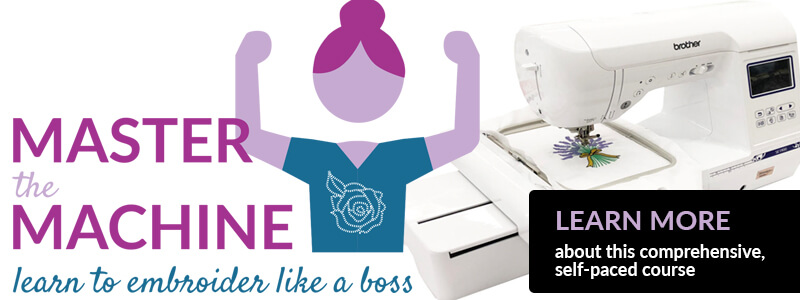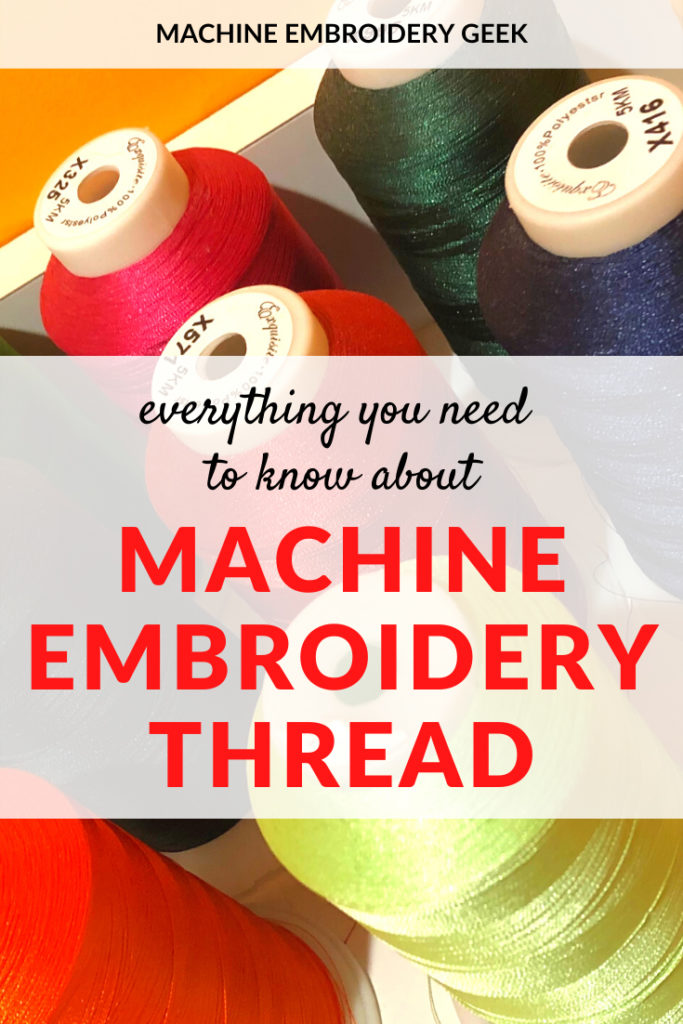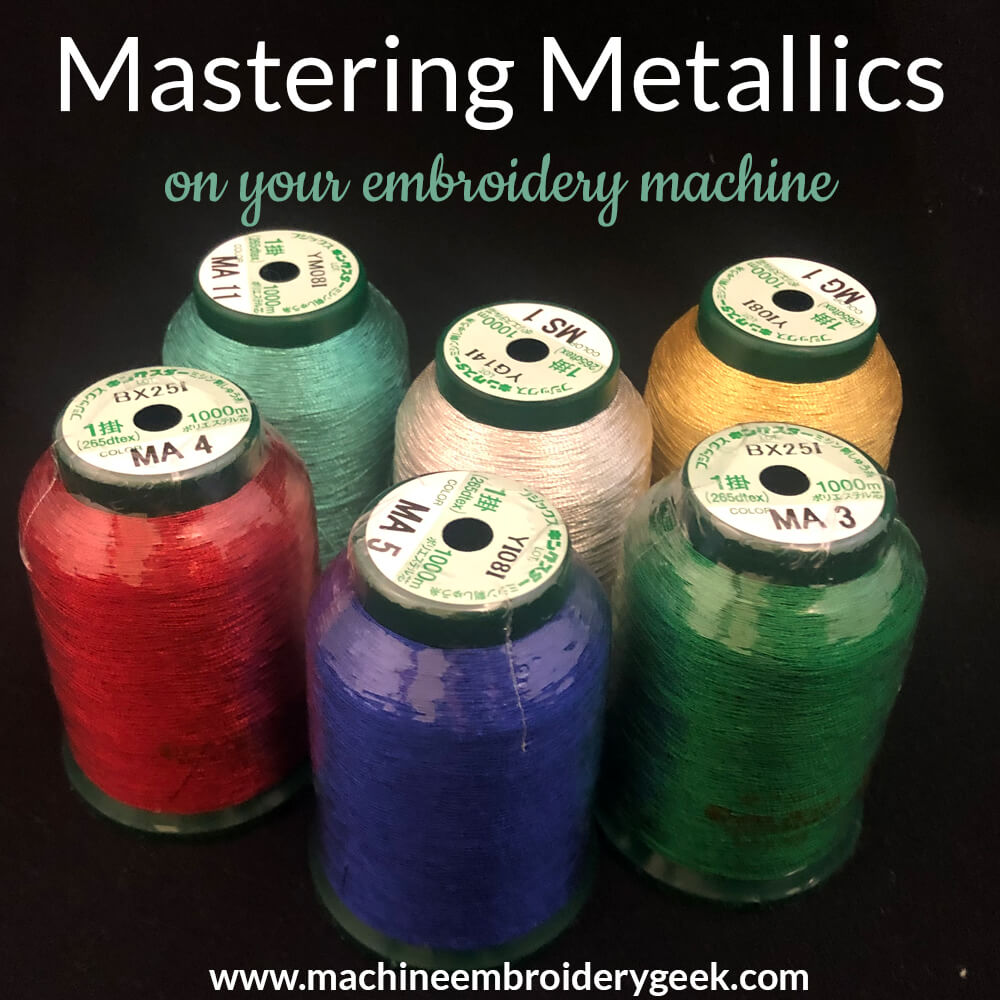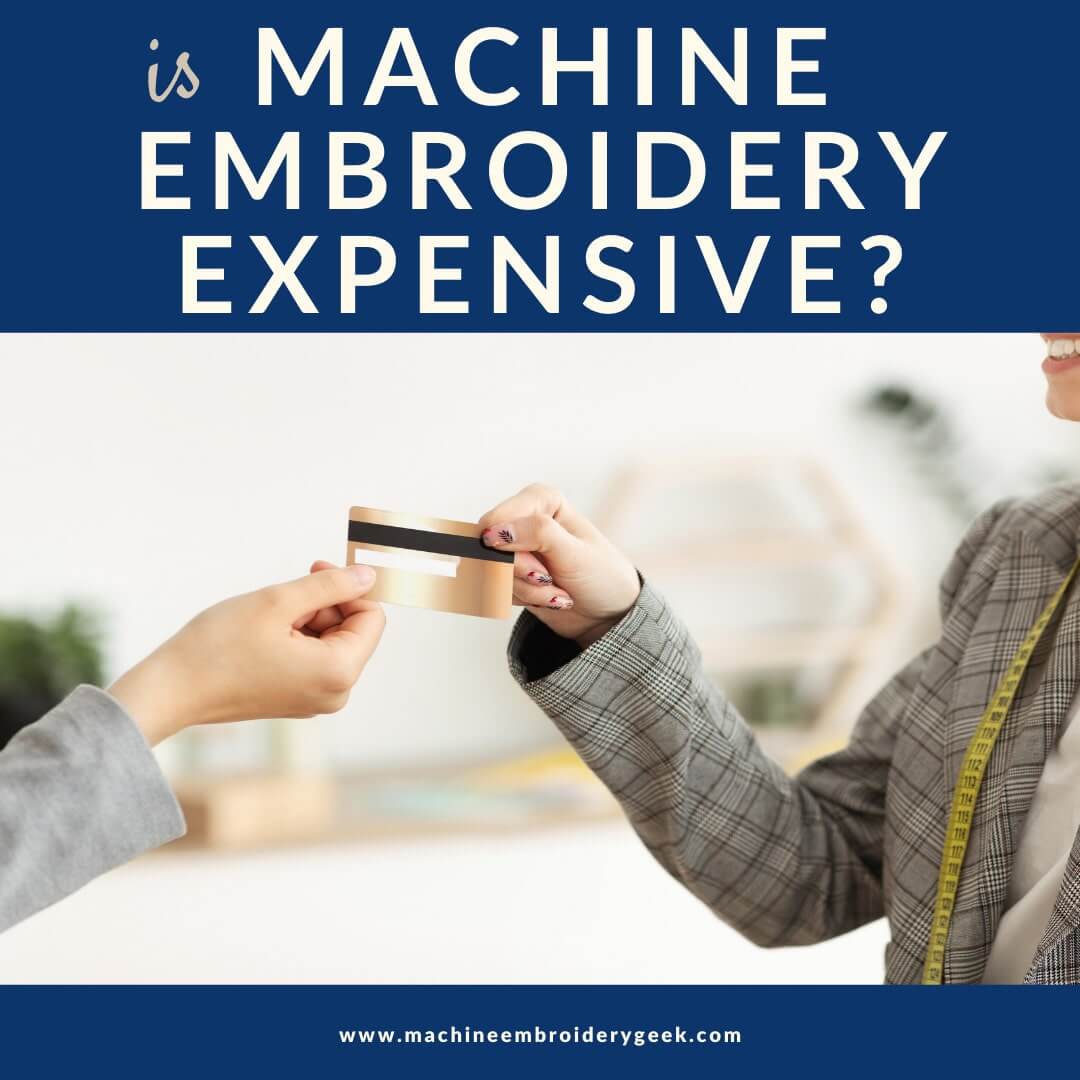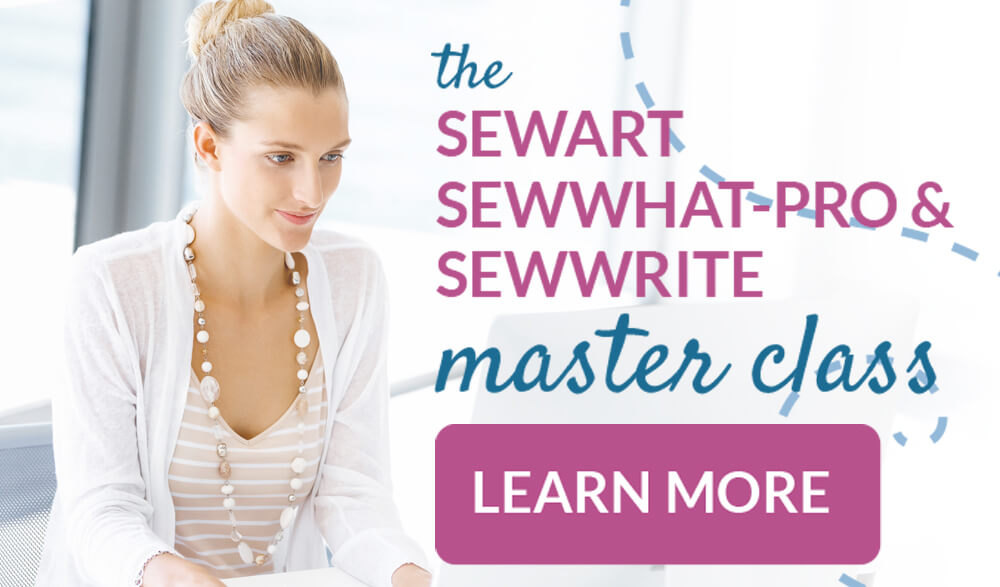What is machine embroidery thread?
This site contains affiliate links to products. We may receive a commission for purchases made through these links.
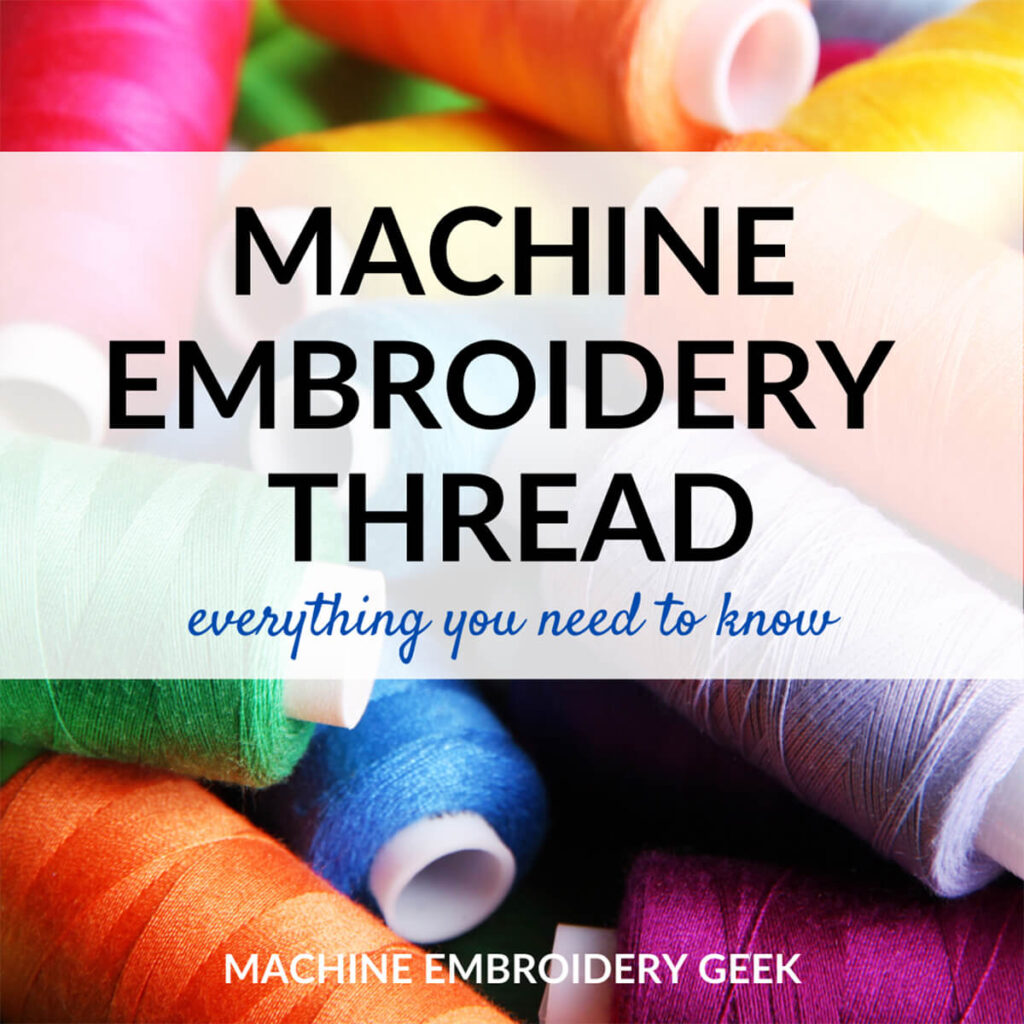
Thread is thread is thread, right? Well, that’s what I thought until I starting getting into machine embroidery. Thread is EVERYTHING when you do machine embroidery because it is the primary ingredient in your craft. When I was first getting started, I owned tons of sewing machine thread. But, I quickly learned that I should not use this type of thread on my embroidery machine. I would have to invest in thread specifically for machine embroidery! And I would need a lot of it – especially if I wanted to create embroidered photorealistic effects. I wondered – what is machine embroidery thread and what makes it so different from regular sewing machine thread?
What makes machine embroidery thread different from regular sewing thread?
Machine embroidery thread is different from regular sewing machine thread in several ways. Just by looking at two spools side by side, you can see that embroidery thread has a pretty sheen too it. Sewing thread is more dull. That sheen is what helps your embroidery look pretty and polished once it’s stitched out.
Embroidery thread is a different weight than regular thread. Your embroidery machine is not made to handle the weight of regular sewing thread. It can throw your machine off and cause problems.
In addition, regular thread has a lot of lint and can gunk up your embroidery machine. A friend of mine put her week-old embroidery machine out of commission by using regular sewing thread on it as it got all gunked up.
Because of these differing properties, it also holds true that you shouldn’t sew with embroidery thread.
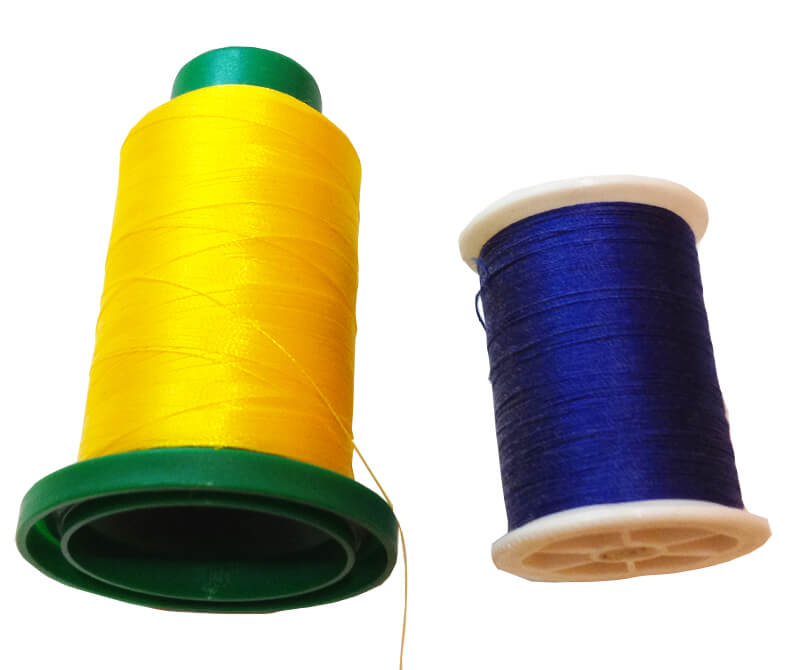
Machine embroidery bobbin thread is also different from regular sewing machine bobbin thread. Typically, when you sew, you match the bobbin thread to the top thread, using the exact same thread. However, with machine embroidery, you should use bobbin thread specifically designed for machine embroidery. This bobbin thread is thinner than the embroidery thread and the unbalance of weight is what keeps your bobbin thread from showing on the top of your design.
Types of machine embroidery thread
It took me quite a while to learn differences between all of the different types of embroidery thread. But, it’s actually pretty simple. There are essentially three different types: cotton, rayon and polyester. Cotton is the thickest and fills in the most. Rayon is the most popular, is shinier than cotton and not quite as thick. Polyester is the toughest of the machine embroidery thread types. It does not break easily and, like the rayon thread, is very shiny.
My personal preference is cotton. I like the thickness and the way it fills. Typically I design and stitch out simpler machine embroidery designs, so for this, cotton machine embroidery thread is most appropriate. Cotton embroidery thread tends to be thicker which is why it tends to fill in shapes nicely. A monogram stitched on a towel looks AMAZING stitched in cotton.
For the very detailed machine embroidery designs, rayon and polyester work best. Rayon is also stronger than cotton; cotton embroidery thread has a reputation of breaking easily.
It’s important to be aware of these differences when combing threads within a design. It would look strange if some of your design is stitched out in a cotton thread while the rest of it is rayon or polyester.
Thread weight
The first time I purchased machine embroidery thread online, I made the discovery that embroidery thread is sold in different weights. I was rapidly adding color after color to my cart, but on the verge of checking out, I noticed that some were labeled with different numbers.
After a little bit of research, I learned that these numbers refer to the weight of the thread. The most common weight of machine embroidery thread is 40. Quilting weight thread is 60, and the weight of cotton machine embroidery thread is 30. I then understood why the cotton machine embroidery thread “filled” so nicely.
I checked some of the threads that I had in my sewing room and confirmed that my Isacord thread was marked with a 40, and the Mettler cotton machine embroidery thread was marked with a 30. Some spools, however, that I thought were cotton machine embroidery thread were actually marked with a 60. They were actually intended for quilting! Had I not learned about thread weight – I would have been very disappointed with the look of the embroidery using that thread.
Favorite thread types
Preferred brands of machine embroidery thread vary from person to person. For every person who religiously buys one brand, there is another one who swears by the cheap stuff. If you are unsure on what type to buy, I would start by looking at your manual. For example, my Bernina manual recommends only working with certain brands of threads such as Mettler, Isacord and Gutermann. But, who knows, maybe these brands paid Bernina for the mention?
Your best bet is to ask other owners of your brand of machine what thread brand they use and start with what they say works well. Then, it becomes a process of trial and error. To be honest, the only thread I’ve had trouble with in the past was the Coats & Clark glow in the dark thread and a Mettler metallic. But the problem with the metallic might have had more to do with my technique than the thread itself.
When I was just getting started with machine embroidery, I surveyed machine embroidery owners about their preferred brands of thread and it was all over the map. Favorite brands included Madeira, Isacord, Floriani, Janome, Marathon, ThreadArt, New Brothread and Embroidex.
Invest in good quality
These veterans also heeded many warnings about buying cheap embroidery thread. They said that sometimes brands of thread advertised as name brands aren’t always what they seem.
[i bought thread from an eBay retailer] and I now have a whole load that I can’t use. It was a recognized brand, but what wasn’t made clear is that it from a subsidiary company in India. Having said that, I have also bought Brother thread, which was fine. A rule of thumb is if it seems too good to be true, it probably is.
Many people warned that buying cheap stuff would lead straight to “snap city.”
Don’t buy the cheap ones!! I have 300+ reels sat in a box completely unusable grrrrr
Mine are in a dump somewhere!
But other people had no problem with less expensive machine embroidery thread.
I must be the odd one out lol I’ve bought the “cheap” ones & got on fine with them x
Improving the performance of any thread
Sometimes it’s not the brand of embroidery thread that is causing problems with your embroidery. Many issues are caused by the condition of your embroidery machine.
Thread position
The first issue can may be how you are the positioning the thread on the machine. Until recently, I did not pay much attention to the location of the spool of thread on my embroidery machine. You see, there are two different locations for the thread, either the vertical or the horizontal thread holder. The location I chose depended on my mood, the weather… who knows – but I never gave it much thought.
A couple of incidents recently changed my thinking. More than once when embroidering with Isacord thread in the vertical position, the thread got stuck and the needle broke. So I moved the thread to the horizontal position and it seemed to work much better. Then someone pointed out that stacked thread goes on the horizontal thread holder and wound thread goes on the vertical holder. The reason why my Isacord embroidery thread seems to work better when placed in the horizontal position is because it is cross wound.
Use a thread stand
If you don’t want to concern yourself with continually changing how you are placing your thread, I find that all my thread works well if I use my thread stand. I started buying big spools of embroidery thread and they wouldn’t unwind properly. It would simply take too much force to pull the thread off the spool. So then I started using a thread stand. Keeping the thread away from my machine allows it to unwind smoothly. Now I use it for any type of thread I’m working with.
Clean the thread path
Problems with thread can occur when the thread path has debris in it. You can often improve the performance of your thread by cleaning the whole thread path well by taking the top front and side plates off.
Smooth out the rough edges or replace the needle
Also, if you’ve broken needles, sometimes that will nick the edge of the hole on the plate which can snag the thread. You can often smooth this out with an emery board and solve your issue. Also, a needle can also have a tiny burr on it which can catch or split the thread. If this is the case, your problem can be rectified by changing the needle.
Use some Sewer’s Aid
The performance of any machine embroidery thread can often be improved by using a bit of Sewer’s Aid. Just dispense a drop of Sewer’s Aid on your index finger and swipe it up one side of the spool. It lubricates the thread and helps it moves through the machine smoothly.
Where to buy machine embroidery thread
I honestly would start by looking on eBay or Facebook marketplace. Someone’s who is trying to unload an estate might be selling embroidery thread for next to nothing.
Probably the easiest place to buy embroidery thread is Amazon. They have great starter packs as well as individual spools of certain brands. However, there are also a lot of specialty retailers that have even more variety.
Other sources recommended for buying machine embroidery thread online include:
Happy stitching + happy shopping!
Julie







